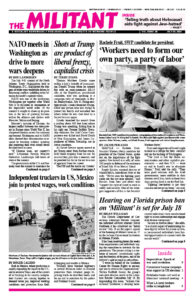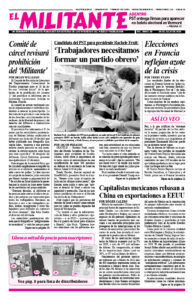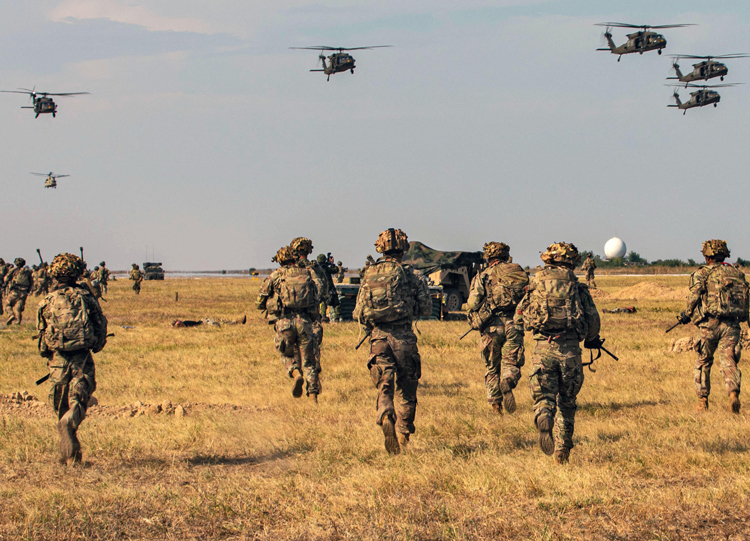The July 9-11 summit of the North Atlantic Treaty Organization held in Washington, D.C., highlighted the dangers of wider wars worldwide driven by deepening conflicts unfolding today between the world’s capitalist rulers.
NATO was one of the institutions Washington put together after World War II to facilitate its domination of the imperialist world order. At the summit it sought to shore up its position in the face of growing frictions within the alliance and clashes with Moscow, Tehran and Beijing.
Moscow’s invasion of Ukraine, the largest conflict between two state powers in Europe since World War II, has sharpened tensions across the continent and beyond. Washington and its NATO allies showed their determination to respond by boosting military spending and preparing their rival armed forces for more wars to come.
“If Ukraine loses, my country’s next.” Lithuanian Foreign Minister Gabrielius Landsbergis told heads of state at the summit.
The governments of the U.S. and Germany used the summit to announce the deployment of longer-range U.S. weapons in Germany, including Tomahawk, multi-mission and hypersonic missiles. The governments of France, Germany, Italy and Poland say they will develop ground-launched cruise missiles that could match those being utilized by Moscow in Ukraine.
The U.S., Canadian and Finnish governments announced new production of ice-breaking vessels that are key for their naval forces to counter Moscow’s reach in Arctic waters.
Governments in Europe’s north and east came seeking closer military links with the U.S. rulers as all move to strengthen their own armed forces. Washington aims to extend its military and political reach and reinforce its central role in the alliance. It’s no accident that the meeting was held in Washington, where it also provided a platform for President Joseph Biden — running for reelection — to boost his tottering image.
Some 100,000 U.S. troops are deployed in Europe, alongside a further 40,000 troops from other countries under NATO command.
Russian President Vladimir Putin’s claim that moves by NATO powers forced his invasion almost two-and-a-half years ago are cynical and false. A sovereign and independent Ukraine poses no military threat to Russia of any kind. Moscow unleashed a deadly missile strike on the children’s hospital in Kyiv July 8, part of its relentless and murderous strategy of bombardment of civilian centers.
By contrast, Ukrainian strikes, mainly against Russian-held Ukrainian territory such as the occupied Crimean Peninsula, only attack military targets.
Washington and its NATO allies announced increased military aid to Ukraine at the summit. They seek an outcome to the war that advances their own capitalist interests. None start from the unconditional defense of Ukraine’s national sovereignty, which can only be secured by the withdrawal of all Moscow’s forces from the territories it has seized in southeastern Ukraine, including Crimea.
A statement by Socialist Workers Party National Secretary Jack Barnes, issued a week after Putin’s 2022 invasion began, explained that defending Ukraine’s sovereignty is in the interests of working people worldwide. It called for the withdrawal of Moscow’s forces and demanded the U.S. rulers get their troops and nuclear arms out of Europe.
The biggest ally the Ukrainian toilers have in this fight is among the workers and farmers in Russia, who have no interest in conquering fellow working people across the border.
Washington seeks to bolster position
Washington sought to use the summit to bolster its position worldwide. For the third year running, the non-NATO allies Japan, South Korea, Australia and New Zealand were invited to the conference. The U.S. rulers see collaboration with these governments as vital to countering the growing weight of Beijing in the Pacific.
Political and military tensions are on the rise between Beijing and Washington-backed governments from the Philippines to Taiwan. The U.S. rulers see the Pacific as their prize for coming out on top in the second imperialist world slaughter.
On July 10 NATO issued a statement accusing Beijing of being “a decisive enabler of Russia’s war against Ukraine,” demanding it cease supplying Moscow with weapons components. Previously, NATO gatherings have refrained from openly condemning Beijing. The Chinese government responded by accusing NATO of “stoking confrontation.”
Coinciding with the NATO summit, Indian Prime Minister Narendra Modi visited Putin in Moscow. This was much to the chagrin of U.S. officials who are trying to forge a closer alliance with the rising Asian power as a counterweight to Beijing.
The Indian rulers also face increased rivalry with Beijing, including over their contested common border. They want to pull Moscow more to their side even as they pursue closer economic and military ties with Washington. India is now the largest buyer of cheap Russian oil, which helps to fuel its expanding economy, and continues to get weapons from Moscow.
US imperialism lost the Cold War
The U.S. rulers pulled together NATO in 1949 amid the ashes of World War II to extend their domination against rival powers in Europe, to better crush rebellions by workers and farmers and to bolster its Cold War with Moscow.
For decades the counterrevolutionary Stalinist police-state regimes in Eastern Europe and the Soviet Union kept working people out of politics. When these regimes disintegrated at the end of the 1980s, Washington mistakenly proclaimed it meant that it had won the Cold War.
Blinded by that illusion, the U.S. rulers launched their 1991 war on Iraq. Rather than heralding a new advance for U.S. imperialism, it paved the way for greater instability and crises, announcing the opening guns of another world war. In 1994-95 and again in 1999 Washington and its NATO allies fueled war in the former Yugoslavia.
In 2021 Washington’s unilateral retreat from its 20-year disastrous occupation of Afghanistan led its allies in NATO to scramble to pull out their own forces deployed there.
As Washington and its NATO allies rearm today, these moves intensify the instability shaking the world. Above all, the preparations for more wars highlight the stakes for workers in organizing as a class to advance an independent working-class foreign policy against the capitalist rulers and governments that serve them.


